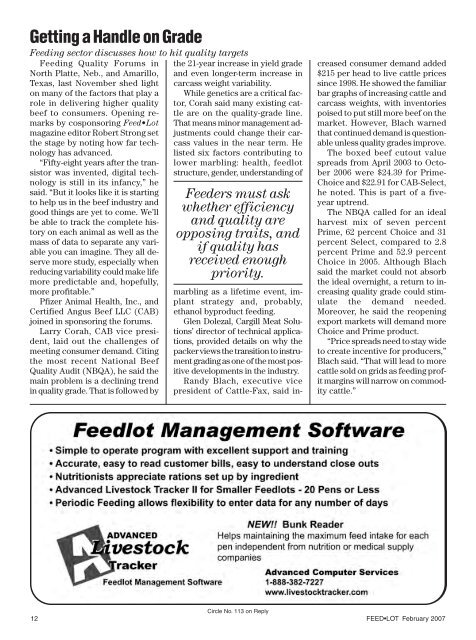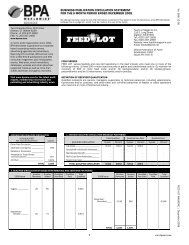February - Feedlot Magazine
February - Feedlot Magazine
February - Feedlot Magazine
- No tags were found...
You also want an ePaper? Increase the reach of your titles
YUMPU automatically turns print PDFs into web optimized ePapers that Google loves.
Getting a Handle on GradeFeeding sector discusses how to hit quality targetsFeeding Quality Forums inNorth Platte, Neb., and Amarillo,Texas, last November shed lighton many of the factors that play arole in delivering higher qualitybeef to consumers. Opening remarksby cosponsoring Feed•Lotmagazine editor Robert Strong setthe stage by noting how far technologyhas advanced.“Fifty-eight years after the transistorwas invented, digital technologyis still in its infancy,” hesaid. “But it looks like it is startingto help us in the beef industry andgood things are yet to come. We’llbe able to track the complete historyon each animal as well as themass of data to separate any variableyou can imagine. They all deservemore study, especially whenreducing variability could make lifemore predictable and, hopefully,more profitable.”Pfizer Animal Health, Inc., andCertified Angus Beef LLC (CAB)joined in sponsoring the forums.Larry Corah, CAB vice president,laid out the challenges ofmeeting consumer demand. Citingthe most recent National BeefQuality Audit (NBQA), he said themain problem is a declining trendin quality grade. That is followed bythe 21-year increase in yield gradeand even longer-term increase incarcass weight variability.While genetics are a critical factor,Corah said many existing cattleare on the quality-grade line.That means minor management adjustmentscould change their carcassvalues in the near term. Helisted six factors contributing tolower marbling: health, feedlotstructure, gender, understanding ofFeeders must askwhether efficiencyand quality areopposing traits, andif quality hasreceived enoughpriority.marbling as a lifetime event, implantstrategy and, probably,ethanol byproduct feeding.Glen Dolezal, Cargill Meat Solutions’director of technical applications,provided details on why thepacker views the transition to instrumentgrading as one of the most positivedevelopments in the industry.Randy Blach, executive vicepresident of Cattle-Fax, said increasedconsumer demand added$215 per head to live cattle pricessince 1998. He showed the familiarbar graphs of increasing cattle andcarcass weights, with inventoriespoised to put still more beef on themarket. However, Blach warnedthat continued demand is questionableunless quality grades improve.The boxed beef cutout valuespreads from April 2003 to October2006 were $24.39 for Prime-Choice and $22.91 for CAB-Select,he noted. This is part of a fiveyearuptrend.The NBQA called for an idealharvest mix of seven percentPrime, 62 percent Choice and 31percent Select, compared to 2.8percent Prime and 52.9 percentChoice in 2005. Although Blachsaid the market could not absorbthe ideal overnight, a return to increasingquality grade could stimulatethe demand needed.Moreover, he said the reopeningexport markets will demand moreChoice and Prime product.“Price spreads need to stay wideto create incentive for producers,”Blach said. “That will lead to morecattle sold on grids as feeding profitmargins will narrow on commoditycattle.”Circle No. 113 on Reply12 FEED•LOT <strong>February</strong> 2007



